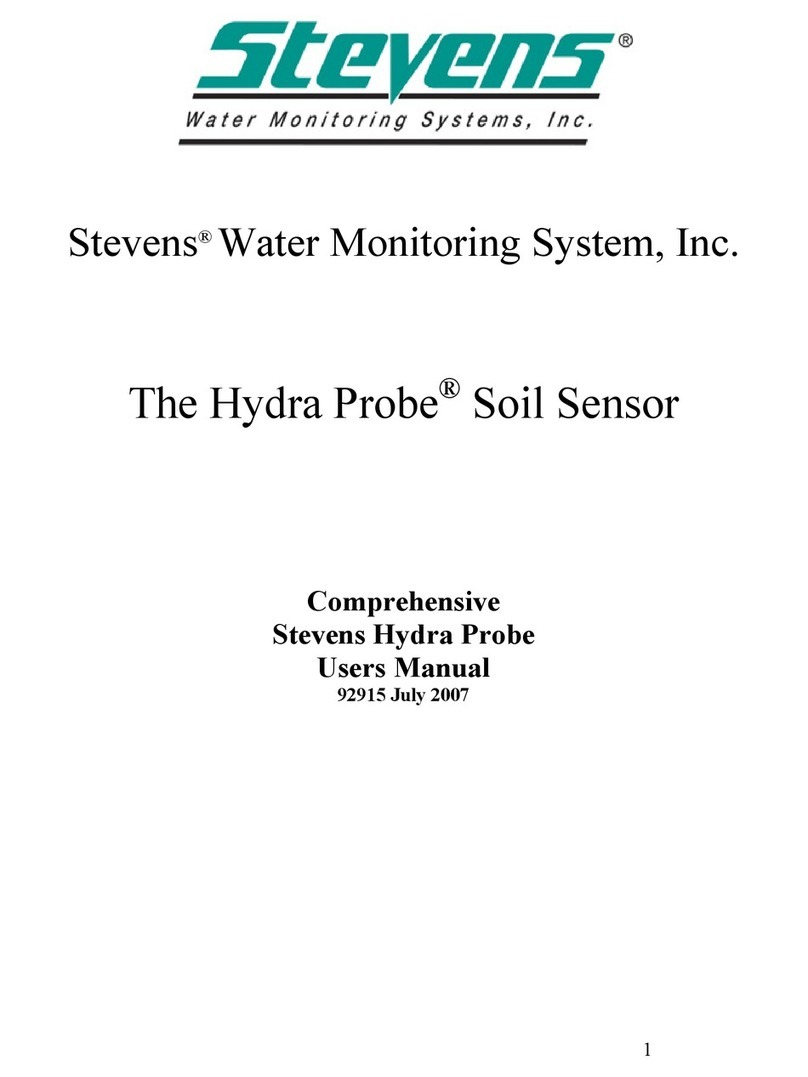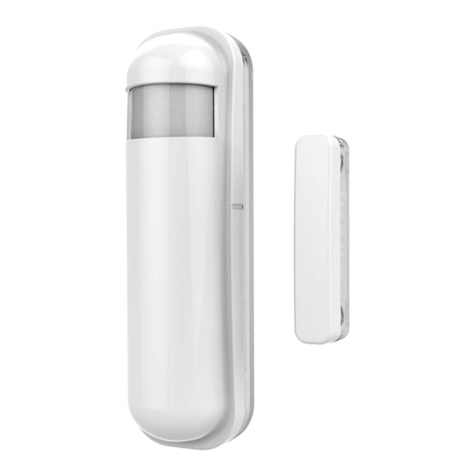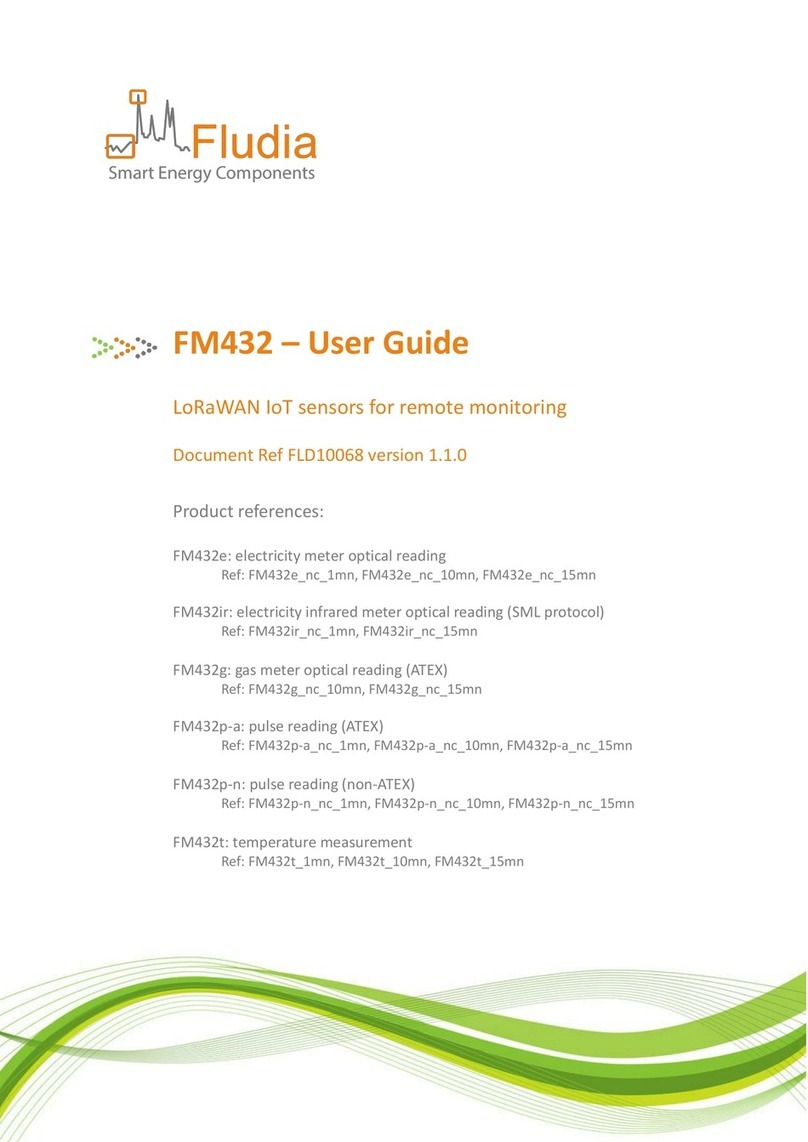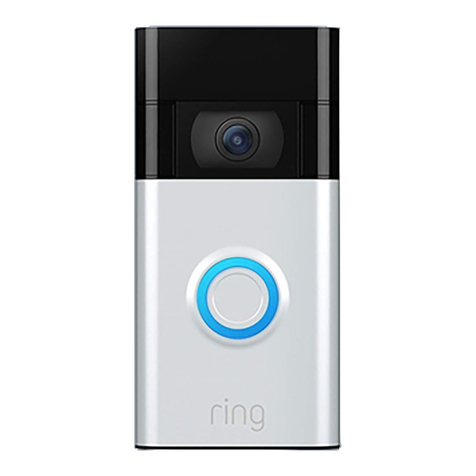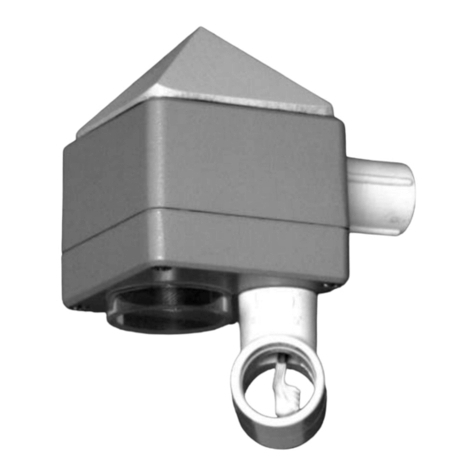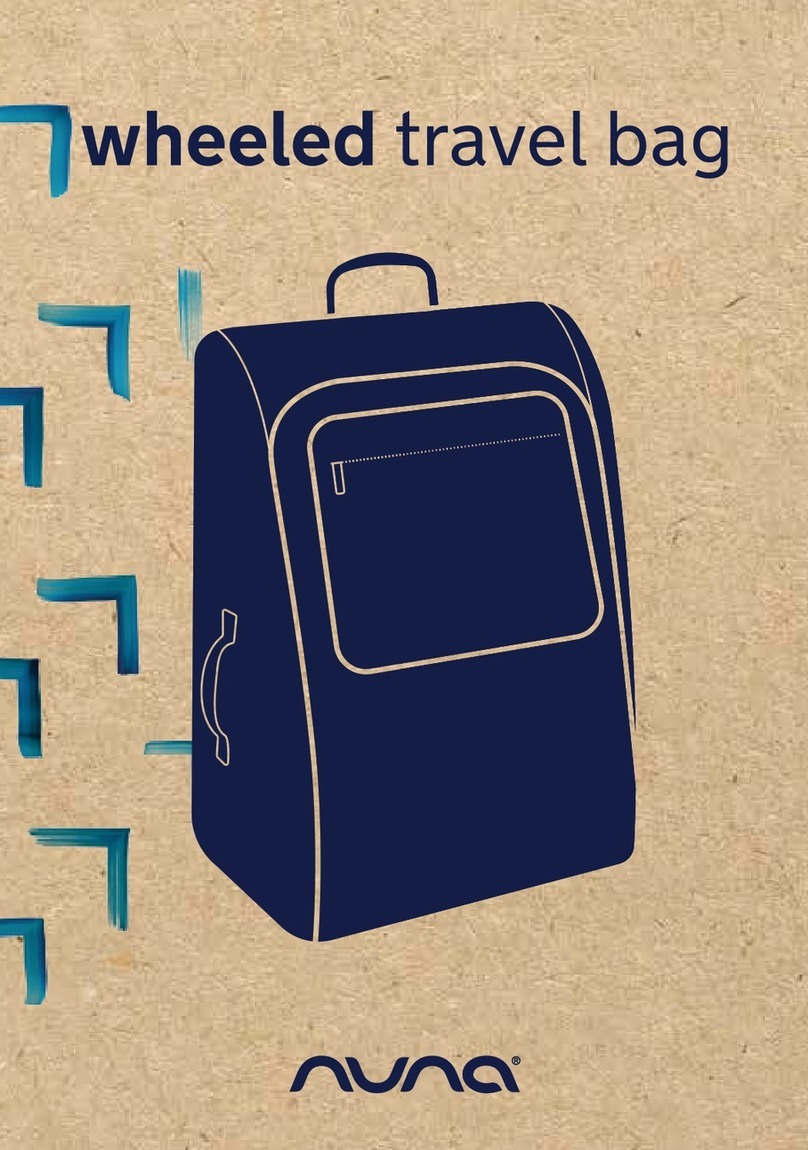Stevens HydraProbe User manual

DOC# HP008A
1
Soil Sensor
®
Installation Guide
Rev. IV
For Firmware Version 6.0

DOC# HP008A
2
Safety and Equipment Protection
WARNING!
ELECTRICAL POWER CAN RESULT IN DEATH, PERSONAL INJURY OR CAN CAUSE DAMAGE TO EQUIPMENT. If the instrument is driven by an external
power source, disconnect the instrument from that power source before attempting any repairs.
WARNING!
BATTERIES ARE DANGEROUS. IF HANDLED IMPROPERLY, THEY CAN RESULT IN DEATH, PERSONAL INJURY OR CAN CAUSE DAMAGE TO
EQUIPMENT. Batteries can be hazardous when misused, mishandled, or disposed of improperly. Batteries contain potential energy, even when partially discharged.
WARNING!
ELECTRICAL SHOCK CAN RESULT IN DEATH OR PERSONAL INJURY. Use extreme caution when handling cables, connectors, or terminals; they may yield
hazardous currents if inadvertently brought into contact with conductive materials, including water and the human body.
CAUTION!
Be aware of protective measures against environmentally caused electric current surges and follow the previous warnings and cautions, the following safety activities
should be carefully observed.
Children and Adolescents
NEVER give batteries to young people who may not be aware of the hazards associated with batteries and their improper use or disposal.
Jewelry, Watches, Metal Tags
To avoid severe burns, NEVER wear rings, necklaces, metal watch bands, bracelets, or metal identification tags near exposed battery terminals.
Heat, Fire
NEVER dispose of batteries in fire or locate them in excessively heated spaces. Observe the temperature limit listed in the instrument specifications.
Charging
NEVER charge "dry" cells or lithium batteries that are not designed to be charged.
NEVER charge rechargeable batteries at currents higher than recommended ratings.
NEVER recharge a frozen battery. Thaw it completely at room temperature before connecting charger.
Unvented Container
NEVER store or charge batteries in a gas-tight container. Doing so may lead to pressure buildup and explosive concentrations of hydrogen.
Short Circuits
NEVER short circuit batteries. High current flow may cause internal battery heating and/or explosion.
Damaged Batteries
Personal injury may result from contact with hazardous materials from a damaged or open battery. NEVER attempt to open a battery enclosure. Wear appropriate
protective clothing, and handle damaged batteries carefully.
Disposal
ALWAYS dispose of batteries in a responsible manner. Observe all applicable federal, state, and local regulations for disposal of the specific type of battery involved.
NOTICE
Stevens makes no claims as to the immunity of its equipment against lightning strikes, either direct or nearby.
The following statement is required by the Federal Communications Commission:
WARNING
This equipment generates, uses, and can radiate radio frequency energy and, if not installed in accordance with the instructions manual, may cause interference to radio
communications. It has been tested and found to comply with the limits for a Class A computing device pursuant to Subpart J of Part 15 of FCC Rules, which are designed
to provide reasonable protection against such interference when operated in a commercial environment. Operation of this equipment in a residential area is likely to cause
interference in which case the user at their own expense will be required to take whatever measures may be required to correct the interference.
USER INFORMATION
Stevens makes no warranty as to the information furnished in these instructions and the reader assumes all risk in the use thereof. No liability is assumed for damages
resulting from the use of these instructions. We reserve the right to make changes to products and/or publications without prior notice.

DOC# HP008A
3
Regulatory
Declaration of Conformity
The Manufacturer of the Products covered by this Declaration is
Water Monitoring Systems, Inc.
12067 NE Glenn Widing Dr. #106
Portland, Oregon 97220 USA
503-445-8000
The Directive covered by this Declaration2004/108/EC Electromagnetic Compatibility directive
The Product Covered by this Declaration
HydraProbe Soil Measurement Sensor
The basis on which Conformity is being Declared
The manufacturer hereby declares that the products identified above comply with the protection requirements of the EMC
directive for and following standards to which conformity is declared: EN61326-1:2006
Electrical requirements for measurement, control, and laboratory use EMC requirements Class A equipment –Conducted
Emissions and Radiated Emissions
1907/2006/EC REACH
Stevens Water Monitoring Systems, Inc. certifies that the Stevens HydraProbe, including all models and components, are compliant with the European
Union Regulation (EC) 1907/2006 governing the Registration, Evaluation, Authorization, and Restriction of Chemicals (REACH) and do not contain
substances above 0.1% weight of a Substance of Very High Concern (SVHC) listed in Annex XIV as of June 15th, 2019.
The technical documentation required to demonstrate that the products meet the requirements of the EMC directive has been
compiled and is available for inspection by the relevant enforcement authorities.
RoHS √

DOC# HP008A
4
Installation of The HydraProbe
See Appendix A for SDI-12 probes and Appendix B for RS485 Probes for wiring and communication.
Calibration is not necessary for most soils and the default settings will accommodate most users and
applications.
Supporting Documents
Document Number
Document
HP003A
HydraProbe Quick Start, SDI-12
HP004A
Soil Data Guide
HP005A
HydraProbe Install and Troubleshooting Guide
HP006A
HydraProbe Quick Start, RS-485
HP007A
Regulatory Information
HP008A
HydraProbe Comprehensive Manual
HP009A
Soil Geomorphology Guide for Soil Sensors
HP010A
Lightning Protection for Meteorological Stations

DOC# HP008A
5
Stevens HydraProbe Installation Guide
Table of Contents
1Introduction 7
Applications.................................................................................................................................8
Calibrations..................................................................................................................................8
Dielectric Permittivity .................................................................................................................8
Structural Components ................................................................................................................8
Accuracy and Precision ...............................................................................................................9
Electromagnetic Compatibility....................................................................................................9
Configurations and Physical Specification..................................................................................9
Soil Data Accessories and other Products .................................................................................10
1.8.1 Portable soil sensors.........................................................................................................10
1.8.2 Tempe Cell.......................................................................................................................11
HydraProbe Versions.................................................................................................................12
2Installation 14
Precautions.................................................................................................................................14
Topographical Station Placement Considerations.....................................................................14
Soil Sensor Depth Selection ......................................................................................................16
Installation of the HydraProbe in Soil .......................................................................................18
2.4.1 Checklist before you go into the field..............................................................................18
2.4.2 Test the probes and logger in the office before going into the field ................................18
2.4.3 Labeling............................................................................................................................18
2.4.4 Installing the HydraProbe in the Soil...............................................................................18
2.4.5 Soil Sensor Orientation ....................................................................................................19
Wiring to a Logger Station ........................................................................................................20
2.5.1 Sensor Setup.....................................................................................................................20
Backfilling the Hole...................................................................................................................20
2.6.1 Test Before you Backfill ..................................................................................................20
Lightning....................................................................................................................................21
3Troubleshooting and Soil Considerations 23
Troubleshooting at the logger end and out of the ground..........................................................23
3.1.1 Check Wiring and Power .................................................................................................23
3.1.2 Communicate with the Sensor at the Logger End............................................................23
3.1.3 Check the Logger Configuration......................................................................................24
3.1.4 Remove the Suspect Probe from the Soil.........................................................................24
Soil Hydrology...........................................................................................................................24
3.2.1 Evapotranspiration ...........................................................................................................25
3.2.2 Hydrology and Soil Texture.............................................................................................25
3.2.3 Soil Bulk Density .............................................................................................................25
3.2.4 Shrink/Swell Clays...........................................................................................................26
3.2.5 Rock and Pebbles .............................................................................................................26
3.2.6 Bioturbation......................................................................................................................26
3.2.7 Salt Affected Soil and the Loss Tangent..........................................................................27

DOC# HP008A
6
3.2.8 Ped Wetting......................................................................................................................27
3.2.9 Frozen Soil .......................................................................................................................28
Appendix A–HydraProbe SDI-12 Communication (6.0 Firmware) 29
Appendix B- HydraProbe RS-485 Communication (6.0 Firmware) 32
Appendix C–Custom Calibration Programming 35
Custom Calibration Procedure for the SDI-12 HydraProbe ...............................................................37
Custom Calibration Settings Procedure for the RS-485 HydraProbe.................................................39
Appendix D - Useful links 41

DOC# HP008A
7
1Introduction
The Stevens HydraProbe Soil Sensor, or the HydraProbe, measures soil temperature, soil moisture, soil electrical
conductivity (EC), and the complex dielectric permittivity. Designed for many years of service buried in soil, the
HydraProbe uses quality material in its construction. Marine grade stainless steel, PVC housing, and a high-grade
epoxy potting protects the internal electrical component from the corrosive and reactive properties of soil. Most
of the HydraProbes installed more than a decade ago are still in service today.
The HydraProbe is not only a practical measurement device; it is also a scientific instrument. Trusted by farmers
to maximize crop yields, using HydraProbes in an irrigation system can prevent runoff that may be harmful to
aquatic habitats, conserve water where it is scarce, and save money on pumping costs. Researchers can rely on
the HydraProbe to provide accurate and precise data for many years of service. The inter-sensor variability is low,
allowing direct comparison of data from multiple probes in a soil column or in a watershed.
The HydraProbe bases its measurements on the physics and behavior of a reflected electromagnetic radio wave
in soil to determine the dielectric permittivity. From the complex dielectric permittivity, the HydraProbe can
simultaneously measure soil moisture and electrical conductivity. The complex dielectric permittivity is related
to the electrical capacitance and electrical conductivity. The HydraProbe uses patented algorithms to convert the
signal response of the standing radio wave into the dielectric permittivity and thus the soil moisture and bulk soil
electrical conductivity.
HydraProbe installation at a typical USDA NRCS SNOTEL Site.
Picture compliments of USDA NRCS in Salt Lake City, Utah.

DOC# HP008A
8
Applications
The US Department of Agriculture Soil Climate Analysis Network (SCAN) has depended on the HydraProbe in
hundreds of stations around the United States and Antarctica since the early 1990s. The Bureau of Reclamation's
Agrimet Network, NOAA, and other mesonets and research watersheds around the world trust the measurements
the HydraProbe provides. Applications of the HydraProbe include:
Agriculture Irrigation
Viticulture Sports Turf
Research Soil Phytoremediation
Water Shed Modeling Evapotranspiration Studies
Land Reclamation Land Slide Studies
Shrink/Swell Clays Flood Forecasting
Satellite Ground Truthing Wetland Delineation
Predicting Weather Precision Agriculture
Calibrations
The HydraProbe has three factory calibrations that provide excellent performance in a variety of soils regardless
of organic content or texture. The three calibrations are: GENERAL (G) good for most all soils composed of
sand, silt, and clay; ORGANIC (O); and ROCKWOOL (R). The factory GENERAL soil calibration is the default
calibration and is suitable for most all mineral soils. (See Chapter 5.4.3 and Appendix C for more information)
Dielectric Permittivity
The complex dielectric permittivities are provided for custom calibrations and other applications. (See Chapter
4.2.2 for more information)
Structural Components
There are three main structural components to the HydraProbe: the tine assembly, body, and cable. The marine
grade stainless steel tine assembly is the four metal rods that extend out of the base plate ground plane and is the
wave guide. Each tine is 58 mm long by 3 mm wide. The base plate is 25 mm in diameter. Electromagnetic waves
at a radio frequency are transmitted and received by the center tine. The head, or body of the probe, contains the
circuit boards, microprocessors, and other electrical components. The outer casing is PVC and the internal
electronics are permanently potted with a rock-hard epoxy resin giving the probes a rugged construction. The
cable has a direct burial casing and contains the power, ground, and data wires that are all soldered to the internal
electronics.

DOC# HP008A
9
Accuracy and Precision
The HydraProbe provides accurate and precise measurements. Table 1.1 below shows the accuracy.
Parameter
Pro/ ET Version
Real Dielectric
Permittivity (isolated)
Range: 1 to 80 where 1 = air, 80 = distilled water
-Accuracy: < +/- 0.5% Or +/- 0.25 dielectric units
Imaginary Permittivity
Range: 0 to 80 where 1 = air, 80 = distilled water
Accuracy: +/- 0.1 up 0.25 S/m and +/-7 at or above
0.5 S/m
Soil Moisture for
inorganic mineral soils
Range: From complete dry to full saturation (0% to
100% of saturation)
Accuracy1: +/-0.01 WFV for most soils (m3,m-3)
+/- 0.03 for fine textured soil
Bulk Electrical
Conductivity (EC)
Range: 0 to 1.5 S/m
Accuracy2: +/- 2.0% or 0.02 S/m whichever is greater
Temperature
Range: -10 to 60oC
ET Range: -30 to 65oC
Accuracy: +/- 0.3oC
Inter-Sensor Variability
+/- 0.012 WFV
Pore Water EC
Hilhorst Equation
Table 1.1 Accuracy and Precision of the HydraProbes’ Parameters.
1Soil Moisture accuracy can vary with soil properties.
2Accuracy and range of Bulk EC depends on soil properties and distribution of ions present.
Electromagnetic Compatibility
The Stevens HydraProbe is a soil sensor that uses low power RF energy. The intended use of the HydraProbe is
to be buried in soil underground to depths ranging from 5 cm to 2 meters deep.
The HydraProbe meets and conforms to the conducted emissions criterion specified by EN 61326-1:2006 and
FCC 15.107:2010 in accordance with method CISPR 11:2009 and ANSI C63.4:2009
The HydraProbe meets the non-intentional radiator emissions, (group A) specified by EN 61326-1:2006, FCC
15.109(g) and (CISPR 22:1997):2010 in accordance with method CISPR 11:2009 and ANSI C63.4:2009 when
the probe is NOT buried as specified. Test results are available upon request. The HydraProbe is RoHS.
Configurations and Physical Specification
The HydraProbe is available in available in both SDI-12 and RS-485, with standard cable lengths of 7.5, 15, and
30 meters.
The two digital formats, SDI-12 and RS-485, incorporate a microprocessor to process the information from the
probe into useful data. This data is then transmitted digitally to a receiving instrument. SDI-12 and RS-485 are

DOC# HP008A
10
two different methods of transmitting digital data. In both versions there are electrical and protocol specifications
that must be observed to ensure reliable data collection.
All configurations provide the same measurement parameters with the same accuracy. The underlying physics
behind how the HydraProbe works and the outer construction are also the same for each configuration. Table 1.2
provides a physical description of the HydraProbe.
Feature
Attribute
Probe Length
12.4 cm (4.9 inches)
Diameter
4.2 cm (1.6 inches)
Sensing Volume1
(Cylindrical measurement region)
Length 5.7 cm (2.2 inches)
Diameter 3.0 cm (1.2 inches)
Weight
200g (cable 80 g/m)
Power Requirements
7 to 20 VDC (12 VDC typical)
Storage Temperature Range
-40 to 75°C
Table 1.2 HydraProbe Physical Description (All Versions)
1The cylindrical measurement region or sensing volume is the soil that resides between the stainless-steel
tine assembly. The tine assembly is often referred to as the wave guide, and probe signal averages the soil
in the sensing volume.
Soil Data Accessories and other Products
1.8.1 Portable soil sensors
Figure 1.1. The portable HydraGO-FLEX and HydraGO-S allow for wireless on the go measurements of soil moisture.
Connect via Bluetooth with a smartphone and the HydraGO App.
There are two portable HydraProbe soil sensor systems, the HydraGO-FLEX and the HydraGO-S. Each model
of the HydraGO has Bluetooth and can connect to a mobile device. The HydraGO App will work with either
Android or Apple iOS devices. The HydraGO-S provides GPS data from the device’s GPS which has a typical
accuracy of 5 to 10 meters depending on the device. The HydraGO FLEX has an internal survey grade GPS,

DOC# HP008A
11
which has sub-meter accuracy depending on satellite conditions. The HydraGO-S has a HydraProbe mounted to
a shaft for quick soil measurements. The HydraGO-FLEX includes a detachable HydraProbe that comes in two
models. One model of the HydraGO Probe has a flexible cable good for spot measurements, down holes, or on-
the-go surface measurements. The second model has a direct buriable grade cable so that the probe can remain
buried underground.
1.8.2 Tempe Cell
The Stevens Tempe Cell System can employ various methods to eliminate the uncertainties from soil moisture
measurements to achieve the highest level of accuracy. This system uses an enhanced gravimetric method to
measure soil moisture to obtain the actual volumetric water content. The volumetric water content determined
gravimetrically can help develop a custom soil moisture calibration equation or to validate the soil moisture value
output from a sensor. In addition to the soil-specific calibration and validation, an algorithm can be developed to
determine the soil’s matric potential using the HydraProbe up to 2 bars of tension. The Stevens Tempe Cell is
ideal for mesonets, climate reference networks, and soil monitoring stations. See Appendix C.
Figure 1.2A. The Tempe Cell for custom calibrations, soil water retention curve

DOC# HP008A
12
Figure 1.2B. Cross sectional diagram of Tempe Cell.
Water is infiltrated from the bottom which pushes the air out the top ensuring full saturation of the soil core.
HydraProbe Versions
•Professional –A scientific instrument designed for long-term climate references, research, and
applications requiring high accuracy and quantitative data assessments.
•Extended Temperature (ET) Professional - Has the same functionality as the professional version but
can operate and measure temperature down to -30oCelsius and is suitable for artic and cold climate
deployments.
Table 1.3. HydraProbe Parameters
Parameter
Unit
Soil Moisture
Water fraction by volume
Bulk EC Temperature Corrected
S/m
Temperature
C
Temperature
F
Bulk EC
S/m
Real Dielectric Permittivity
-
Imaginary Dielectric Permittivity
-
Pore Water EC
S/m
Dielectric Loss Tangent
-

DOC# HP008A
13
Manufacturer Part # Description
56012-02
SDI-12, Professional, w/25 ft. cable
56012-02-30
SDI-12, Professional (Extended Temp), w/25 ft. cable
56012-04
SDI-12, Professional, w/50 ft. cable
56012-04-30
SDI-12, Professional (Extended Temp), w/50 ft. cable
56012-06
SDI-12, Professional, w/100 ft. cable
56012-06-30
SDI-12, Professional (Extended Temp), w/100 ft. cable
Table 1.4 Stevens part numbers for SDI-12 HydraProbes
Manufacturer Part #
Description
56485-02
RS485, Professional, w/25 ft. cable
56485-02-30
RS485, Professional (Extended Temp), w/25 ft. cable
56485-04
RS485, Professional, w/50 ft. cable
56485-04-30
RS485, Professional (Extended Temp), w/50 ft. cable
56485-06
RS485, Professional, w/100 ft. cable
56485-06-30
RS485, Professional (Extended Temp), w/100 ft. cable
Table 1.5 Stevens part numbers for RS485 HydraProbes
HydraProbe Accessories
93633-007
HydraGO-S Portable Soil Sensor
93633-009
HydraGO FLEX Portable Soil Sensor with GPS
51169-100
Tempe Cell Basic Kit
93723
SDI-12 / RS-485 Multiplexer, 12 Position
93539
Cable, RS-485 Probe, 5 conductor (1000' spool)
93924
Cable, SDI-12 Probe, 3 conductor (2500' spool)
Table 1.6 Stevens part numbers for accessories

DOC# HP008A
14
2Installation
Precautions
To avoid damage to the HydraProbe. DO NOT:
●Subject the probe to extreme heat over 70 degrees Celsius (160 degrees Fahrenheit).
●Subject the probe to fluids with a pH less than 4.
●Subject the probe to strong oxidizers like bleach, or strong reducing agents.
●Subject the probe to polar solvents such as acetone.
●Subject the probe to chlorinated solvents such as dichloromethane.
●Subject the probe to strong magnetic fields.
●Use excessive force to drive the probe into the soil as the tines could bend. If the probe has difficulty going
into the soil due to rocks, simply relocate the probe to an area slightly adjacent.
●Remove the HydraProbe from the soil by pulling on the cable.
While the direct burial cable is very durable, it is susceptible to abrasion and cuts by shovels. Use extra caution
not to damage the cable or probe if the probe needs to be excavated for relocation.
Do not place the probes in a place where they could get run over by tractors or other farm equipment. The
HydraProbe may be sturdy enough to survive getting run over by a tractor if it is buried; however, the compaction
of the soil column from the weight of the vehicle will affect the hydrology and thus the soil moisture data.
DO NOT place more than one probe in a bucket of wet sand while logging data. More than one HydraProbe in
the same bucket while powered may create an electrolysis effect that may damage the probe.
Topographical Station Placement Considerations
The land topography often dictates the soil hydrology. Depending on what you’d like to measure, the placement
of the HydraProbe should be in the most useful area to measure.
Some factors to consider prior to HydraProbe placement are tree canopy, slope, surface water bodies, and geology.
Tree canopy may affect the influx of precipitation/irrigation. Upper slopes may be better drained than depressions.
There may be a shallow water table near a creek or lake. Hill sides may have seeps or springs.

DOC# HP008A
15
Figure 2.1 Ground water pathways and Surface water. Taken from USGS Report 00-4008.
Figure 2.2 Ground water flow direction and surface water body. Taken from USGS report 00-4008.
Figures 2.1 and 2.2 illustrate subsurface water movement in the water table. The HydraProbe data is most
meaningful in the unsaturated zone where soil moisture values will fluctuate. If the water table rises to the depth
of the HydraProbe, the HydraProbe soil moisture measurements will be at saturation and will be indicative of the
porosity. If you are interested in groundwater level measurements in wells, a water depth sensor might provide
the necessary information.

DOC# HP008A
16
Soil Sensor Depth Selection
Like selecting a topographical location, selecting the sensor depth depends on the interest of the user. Farmers
may be interested in the root zone depth while soil scientists may be interested in the soil horizons.
For those in agriculture, two to three HydraProbes may be installed in the root zone and one HydraProbe may be
installed beneath the root zone; this would also be dependent upon the crop and root zone depth. The amount of
water that should be maintained in the root zone can be calculated by the method described in section 5. The
probe beneath the root zone is important for measuring excessive irrigation and downward water movement.
Figure 2.3 Six HydraProbes installed into 6 distinct soil horizons.
The soil horizons often dictate the depths of the Stevens HydraProbe placement. Soil scientists and groundwater
hydrologists are often interested in studying soil horizons. The HydraProbe is ideal for this application because
of the accuracy and precision of the volumetric water fraction calibrations. Soil horizons are distinct layers of soil
that form naturally in undisturbed soil over time. The formation of soil horizons is called soil geomorphology and
the types of horizons are indicative of the soil order (see table 2.1). Like other natural processes, the age of the
horizon increases with depth. The reason why it is so useful to have a HydraProbe in each horizon is because
different horizons have different hydrological properties. Some horizons will have high hydraulic conductivities
and thus have greater and more rapid fluctuations in soil moisture. Some horizons will have greater bulk densities
with lower effective porosities and thus have lower saturation values. Some horizons will have clay films that
will retain water at field capacity longer than other soil horizons. Knowledge of the soil horizons in combination
with the HydraProbe’s accuracy will allow the user to construct a more complete picture of the movement of
water in the soil. Thehorizons that exist near the surface can be 6 to 40 cm in thickness. In general, with increasing
depth, the clay content increases, the organic matter decreases, and the base saturation increases. Soil horizons
can be identified by color, texture, structure, pH, and the visible appearance of clay films.
More information about soil horizons is provided by the USDA National Resource Conservation Service’s
website for a Soil’s Profile under their Soil Education section.

DOC# HP008A
17
More information about the soil horizons in your area can be found on the USDA’s soil survey page.
Soil Horizon
Property
O
Decaying plants on or near surface
A
Top Soil, Organic Rich
B
Subsoil, Most Diverse Horizon and the Horizon with the most sub classifications
E
Leached Horizon (light in color)
C
Weathered/aged parent material
Table 2.1 Basic description of soil horizons.
Figure 2.4 Soil Horizons. Figure 2.5 Illustration of soil horizons. In this frame,
the soil horizons are very distinct and show the geological
history of the soil.

DOC# HP008A
18
Installation of the HydraProbe in Soil
2.4.1 Checklist before you go into the field
Here is a list of helpful and recommended items to take into the field:
Notepad and pen
Shovel
Knife
Trowel
Tape measure
Zip ties
Screw drivers
Gloves
Water/food
Muncell Color book
Wrench
Toe tags for labeling probes
Wire cutter and wire strippers
Needle nose plyers
Water bottle (for cleaning)
Rags and towels
Handheld voltmeter
Marker flags
2.4.2 Test the probes and logger in the office before going into the field
We recommend setting up and running the system with the logger and the sensors before installing in the field.
This allows users to become familiar with the system and identify any issues that may arise. The HydraProbes
can be placed in water to test functionality. See Appendix A for SDI-12 communication and Appendix B for RS-
485 communication or the quick start guides to take readings and test probes.
2.4.3 Labeling
We recommend labeling the sensor at the head prior to installation for quick identification before going in the
hole. The cable at the logger end should also be labeled. The serial number and address should be documented.
The serial number is printed on the label or use the SDI-12 “aI!” (aaaXR_SN for RS485) command to get the
serial number.
2.4.4 Installing the HydraProbe in the Soil
The most important factor when installing the HydraProbe is that the soil should be undisturbed, and the base
plate of the probe needs to be flush with the soil. Once the soil is disturbed from its pedology or equilibrated state,
the porosity will increase which will in turn affect the way water is held and moves through the soil. To install
the probe into the soil, first select the depth (see Chapter 2.3 for depth selection). We recommend the use of a
post-hole digger or spade to dig the hole. If a pit has been prepared for a soil survey, the HydraProbes can be
installed into the wall of the survey pit before it is filled in. Use a paint scraper to smooth the surface of the soil
where it is to be installed. The soil must be flush with the base plate. If there is a gap, the HydraProbe signal will
average the gap into the soil measurement and create errors.
If it is not possible to install the probe in undisturbed soil such as a bore hole application. The soil will settle over
time and the soil around the probe will once again reach an equilibrium. If possible, the soil should be put back
into the bore hole the way it came out so that the sensor is surrounded with the same material that exists at that
specific depth.

DOC# HP008A
19
Figure 2.6 HydraProbe Installed in undisturbed soil.
Push the tines of the HydraProbe into the soil until the base plate is flush with the soil. The tines should be parallel
with the surface of the ground. Do not rock the probe back and forth because this will disturb the soil and create
a void space around the tines.
It is imperative that the bulk density of the soil in the probe’s measurement volume remain unchanged from the
surrounding soil. If the bulk density changes, the volumetric soil moisture measurement and the soil electrical
conductivity will change.
2.4.5 Soil Sensor Orientation
Figure 2.7 Horizontal placement sensor and dipping the cable is recommended
We recommend keeping the tine assembly horizontal with the ground particularly near the surface. A drain loop
can be put in the cable to prevent water from running down the cable to the probe’s sensing area.

DOC# HP008A
20
Wiring to a Logger Station
Connect the red wire to a +12 volt DC power supply and connect the black wire to the ground for all HydraProbe
models. The measurement duty cycle is 2 seconds.
Wiring and power for HydraProbes
Power Requirements
9 to 20 VDC (12VDC Ideal)
Red Wire
+Volts Power Input
Black Wire
Ground
Green Wire
Data Signal A inverting signal (-)
White Wire
Data Signal B non-inverting signal (+)
Blue Wire
SDI-12
Power Consumption RS-485
<10 mA Idle 30 mA Active for 2s
Power Consumption SDI-12
<1 mA Idle 10 mA Active for 2s
Table 2.2 Wiring connections and power considerations.
You may also want to run the HydraProbe cable through a metal conduit like the one shown in figure 2.3 to add
extra protection to the cable.
Once the probes are wired to the logger, test the communication between the logger and all the probes. This can
be achieved by current reading features in the logger or in SDI-12 transparent mode. See Appendix A for SDI-12
commands or Appendix B for RS-485 commands.
2.5.1 Sensor Setup
We recommend for most applications of the HydraProbe to use the default factory settings and the factory soil
moisture calibration which accommodates most all soil types. The default soil moisture calibration is called
GENERAL and most users will not need to change it. If you have unique soil that requires a one of the other
factory calibrations or a site-specific calibration, see Appendix C.
Backfilling the Hole
2.6.1 Test Before you Backfill
When the probes are securely installed in the undisturbed soil, test the communication between the logger and the
probes. You can do this by the current reading features in the logger or in SDI-12 transparent mode. See Appendix
Afor SDI-12 commands or Appendix B for RS-485 commands.
Backfilling Precautions. The horizons and soil become physically homogenized after soil is removed from the
ground and piled up next to the hole. The bulk density decreases considerably because the soil structure has been
disturbed. After the probes are installed into the wall of the pit, the pit needs to be backfilled with the soil that
came out it. It is impossible to put the horizons back the way they have formed naturally, but the original bulk
density can be approximated by compacting the soil. For every 24 cm (1 foot) of soil put back into the pit, the
soil should be compacted. Compaction can be done by trampling the soil with feet and body weight. Mechanical
compactors can also be used, though typically they are not required. Extra care must be taken not to disturb the
Table of contents
Other Stevens Accessories manuals
Popular Accessories manuals by other brands

SEELEY INTERNATIONAL
SEELEY INTERNATIONAL Breezair EXQ owner's manual
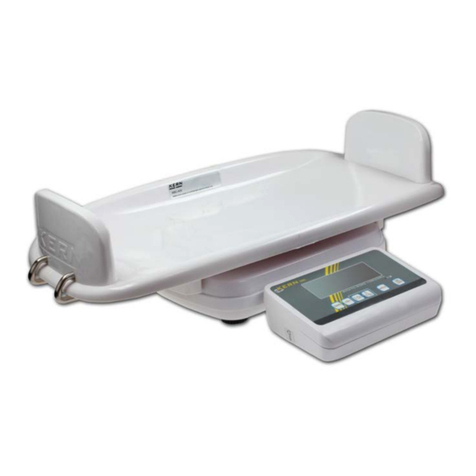
KERN
KERN MBC-A05 Assembly instructions
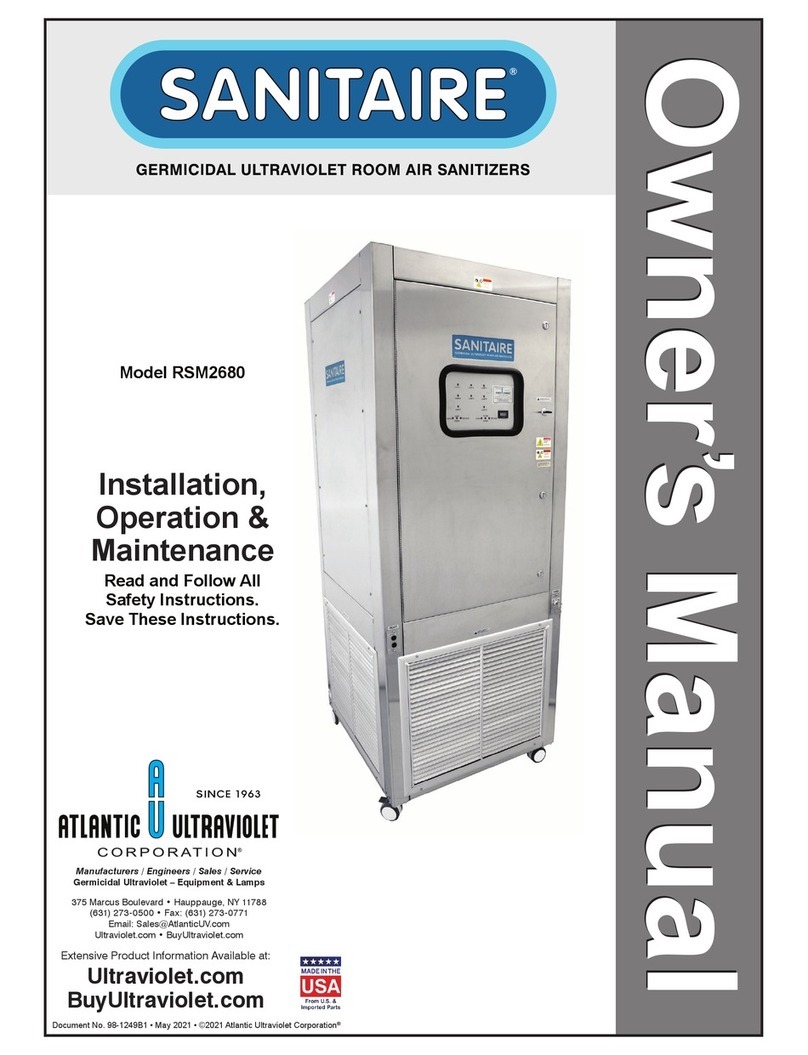
Atlantic Ultraviolet
Atlantic Ultraviolet SANITAIRE RSM2680 Installation operation & maintenance
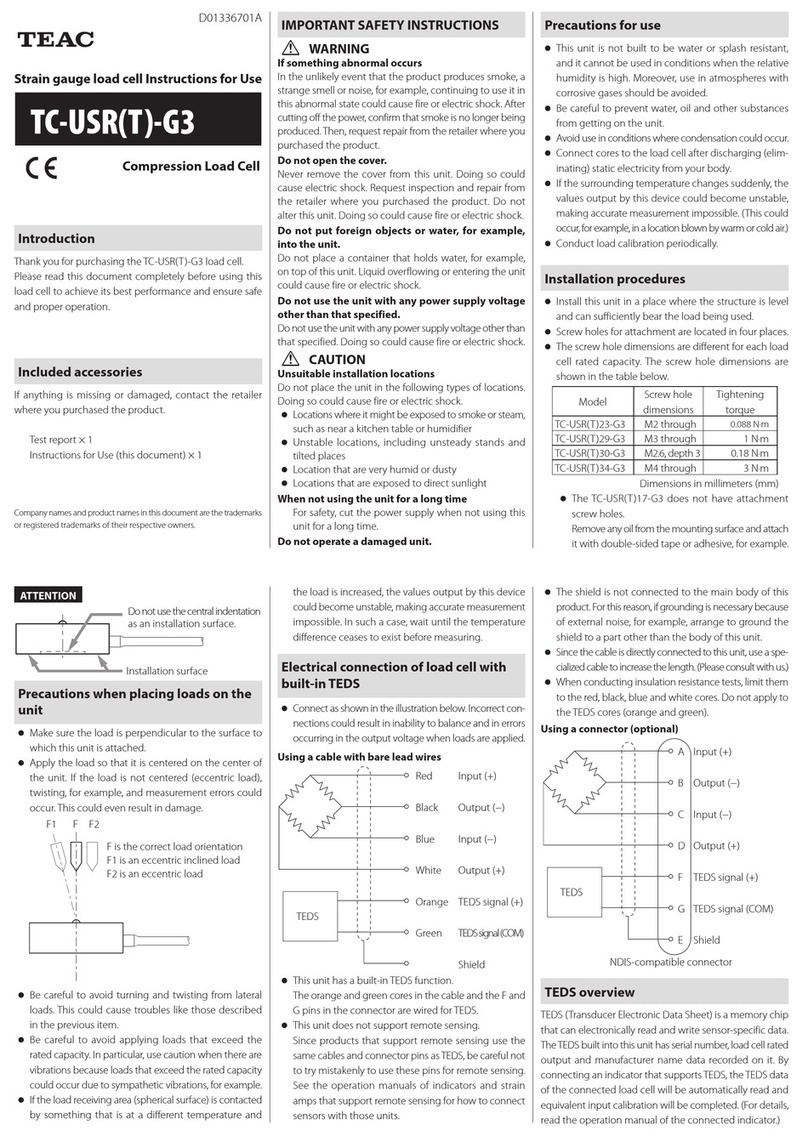
Teac
Teac TC-USR(T)23-G3 Instructions for use
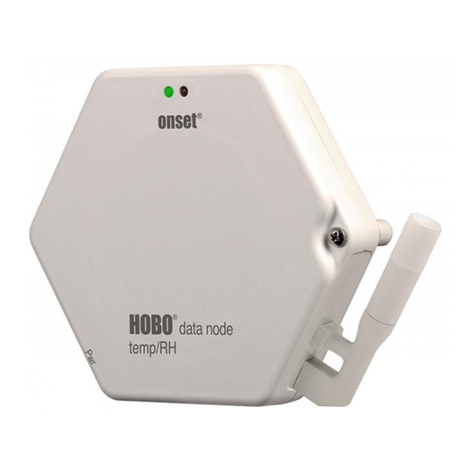
ALAT UJI
ALAT UJI HOBO ZW-003 quick start guide

Gastro-Cool
Gastro-Cool GCGD800 Instructions for use
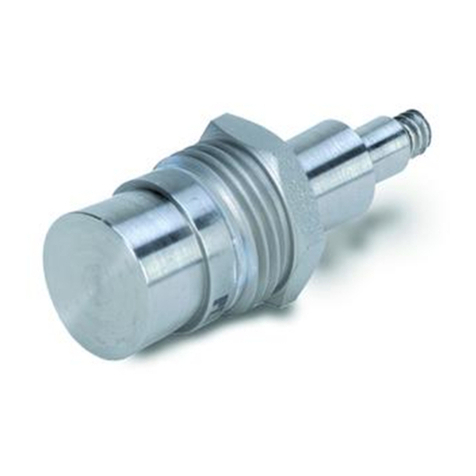
PCB Piezotronics
PCB Piezotronics 106B50 Installation and operating manual
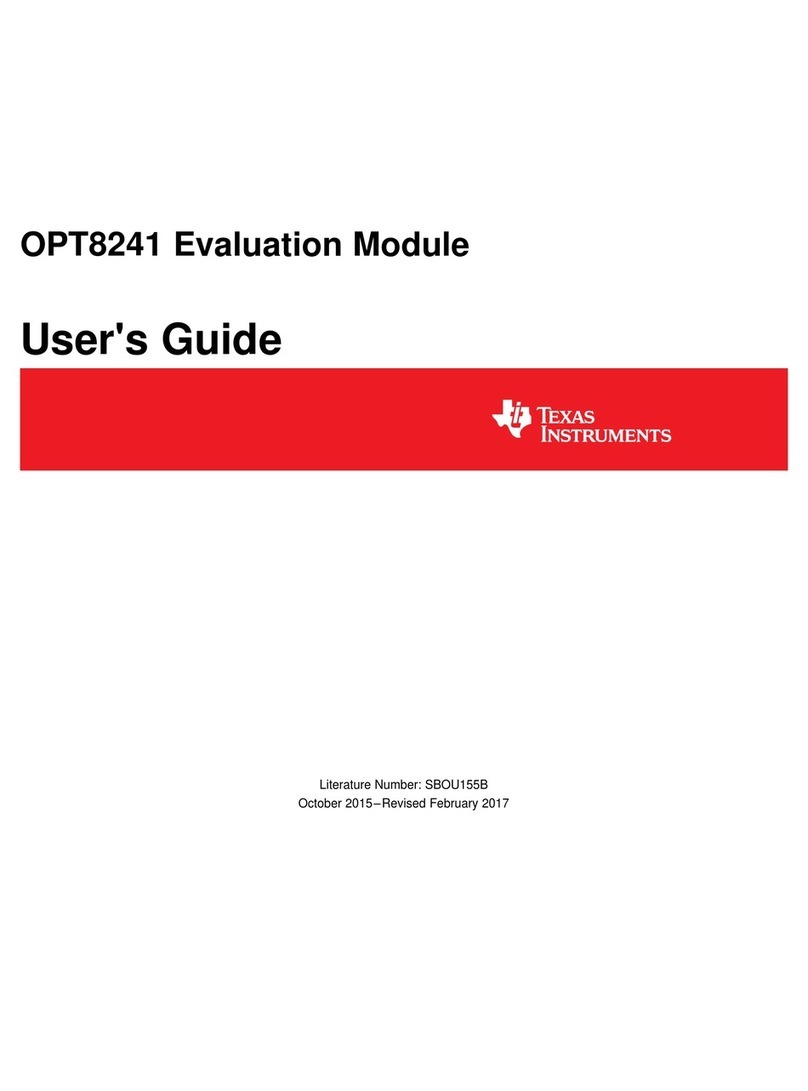
Texas Instruments
Texas Instruments OPT8241 user guide

chinavasion
chinavasion CVSN-G672 Operation lnstruction
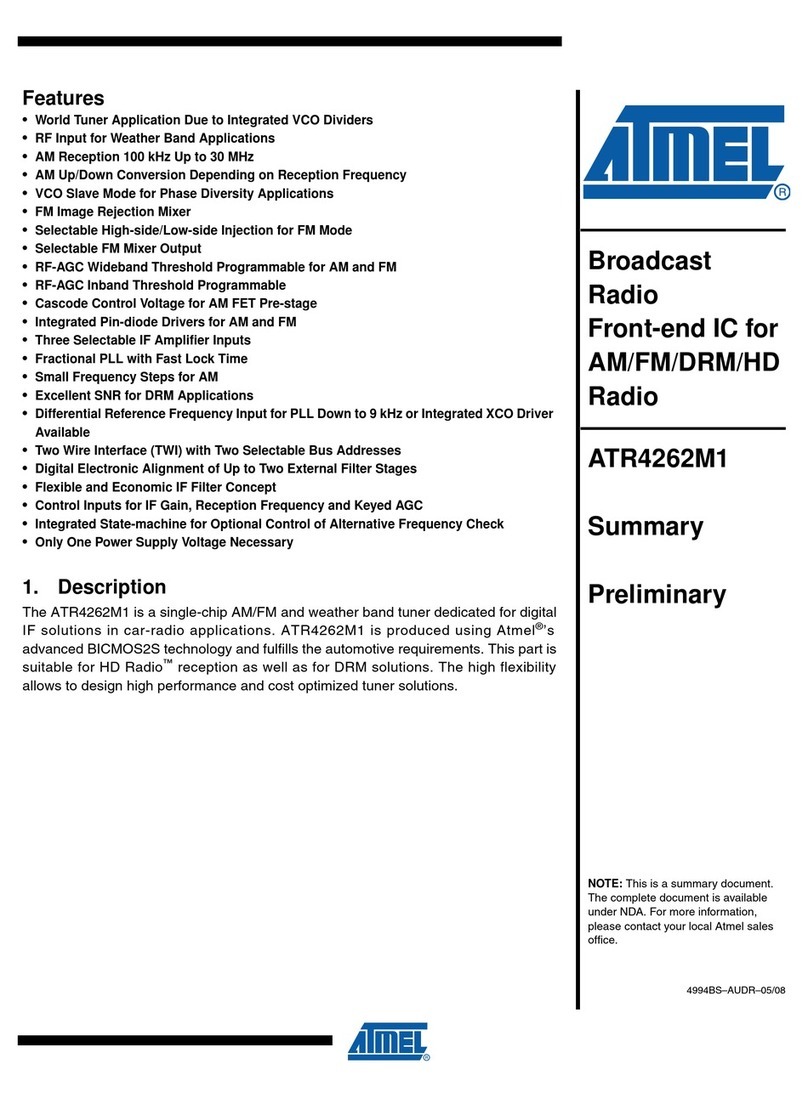
Atmel
Atmel ATR4262M1 Specification sheet
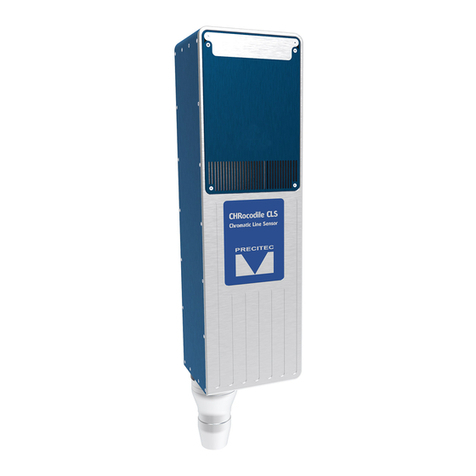
PRECITEC
PRECITEC CHRocodile CLS0.2 Operation manual
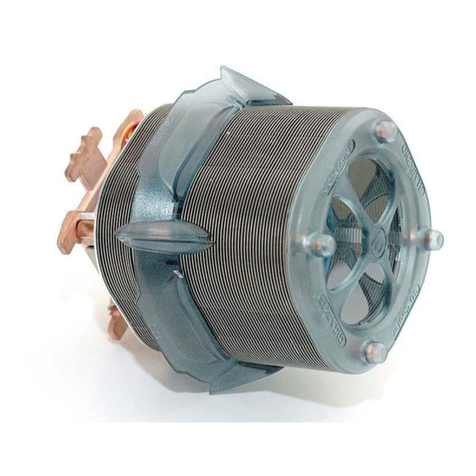
Gigabyte
Gigabyte 3D Rocket installation guide
